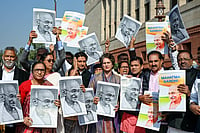Even 15 years ago, those who took climate change seriously, saw it as something that will happen far away in the future – maybe affecting their grandchildren. But with unprecedented heatwaves in European cities and severe cold waves in the tropics, the effects of climate change are visible to all of us today. India, too, has already been badly impacted by climate change. Average rainfall levels have been falling, while erratic heavy rains are disrupting agricultural seasons and causing floods. This has destroyed the livelihoods of millions of people and forced them to migrate to other places.
The Centre for Science and Environment (CSE) has estimated that in 2022 alone, more than 2.5 million Indians were internally displaced because of climate change. The CSE’s report ‘2023 State of India’s Environment in Figures’, released on Sunday, says that there were 314 extreme weather events last year. The states that were worst affected by extreme weather were Uttar Pradesh, Delhi, Punjab, Haryana, and Madhya Pradesh. These extreme weather events not only led to extreme heat, cold and rain but also cost lives. CSE’s report estimates that 3,026 people died as a direct result of extreme weather – over 80 per cent during the monsoon season. More than 60 per cent of these deaths were recorded in the northwestern and central regions.
The report estimates that 1.96 million hectares of agricultural land were damaged by extreme weather events in 2022 alone, leading to significant crop losses to farmers. According to the Climate Transparency Report 2022, Indian farmers lost $ 3.75 billion because of crop failure, between 2016-21, because of extreme weather. Climate change-related extreme weather events resulted in a loss of nearly 36 million hectares of cropped area. A study by the Punjab Agricultural University (PAU) estimates that if average temperatures continue to rise at the present rate, Punjab will see a significant drop in crop yields by 2050. Maize is likely to see a drop of 13 per cent, cotton 11 per cent, 5 per cent in wheat and potato, and paddy yields could drop by one per cent.
It is not just agriculture which has been and will be, affected by climate change. According to the Climate Transparency Report 2022, in 2021 alone India lost an equivalent of 5.4 per cent of its GDP due to extreme weather events, across all sectors of the economy. Extreme heatwave conditions caused a loss of 167 billion potential labour hours. The report predicts that if global temperatures rise by another 1.5 degrees Celsius, India’s average labour productivity will drop by 5 per cent, and it will drop by more than 10 per cent if global temperatures rise by 2.5 degrees Celsius.
Speaking on the occasion of World Environment Day, Prime Minister Narendra Modi said that India is moving ahead on tackling climate change while balancing its development needs. ‘The theme of this year's World Environment Day is to get rid of single-use plastic, an issue about which the world is talking today but India has been working on it consistently for the last four-five years,’ he said. PM said that while India is committed to helping the poor, it is also focusing on clean and green energy.
India launched the National Action Plan for Climate Change (NPACC) 15 years ago, which is designed by the Prime Minister’s Council on Climate Change (PMCCC). It has eight submissions that focus on promoting solar power, enhanced energy efficiency, sustainable habit, sustainable water supply, protecting and sustaining the Himalayan ecosystem, greening India, promoting sustainable farming, and generating strategic knowledge on climate change.
However, environmentalists and activists say that while these are steps in the right direction, the NPACC needs more teeth and accountability as some of the targets are unachievable. For instance, the Modi government had announced in 2015 that India will have 100 GW of installed solar power capacity by 2020, but as per the available data, to date, only 36 GW could be achieved. The government has also been criticised for not providing enough budgetary support to its climate-change management programmes. The good news, however, is that there is a growing awareness among ordinary citizens that climate change has to be tackled on an urgent basis. India Inc is also contributing both financially and in its corporate practices to help control climate change.
State of India’s Environment: Where Does It Stand And Who Is Accountable For It?
With unprecedented heatwaves in European cities and severe cold waves in the tropics, the effects of climate change are visible to all of us today.

Climate change activism.
Climate change activism.
Published At:
MOST POPULAR
WATCH
MORE FROM THE AUTHOR
PHOTOS
×





















